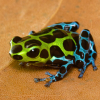Some of the annoying things that happened to me on the 10 hr queen hunting trip were:
Test tubes had condensation
Solution: I think I will put them in waterless test tubes and transfer them into water and cotton filled test tubes at home.
I had a lot of dirt on my hands from sifting through what I dug out, and it got itchy/uncomfortable after a while.
Solution: I think I will bring a latex glove.
I went too early, no mating going on with the species I found.
Solution: I think I will try to get there around 4-5 p.m. instead.
If you have any advice for me for a better expedition since I am new to this, I would be grateful.
Edited by Tagassi, March 12 2017 - 10:42 PM.















